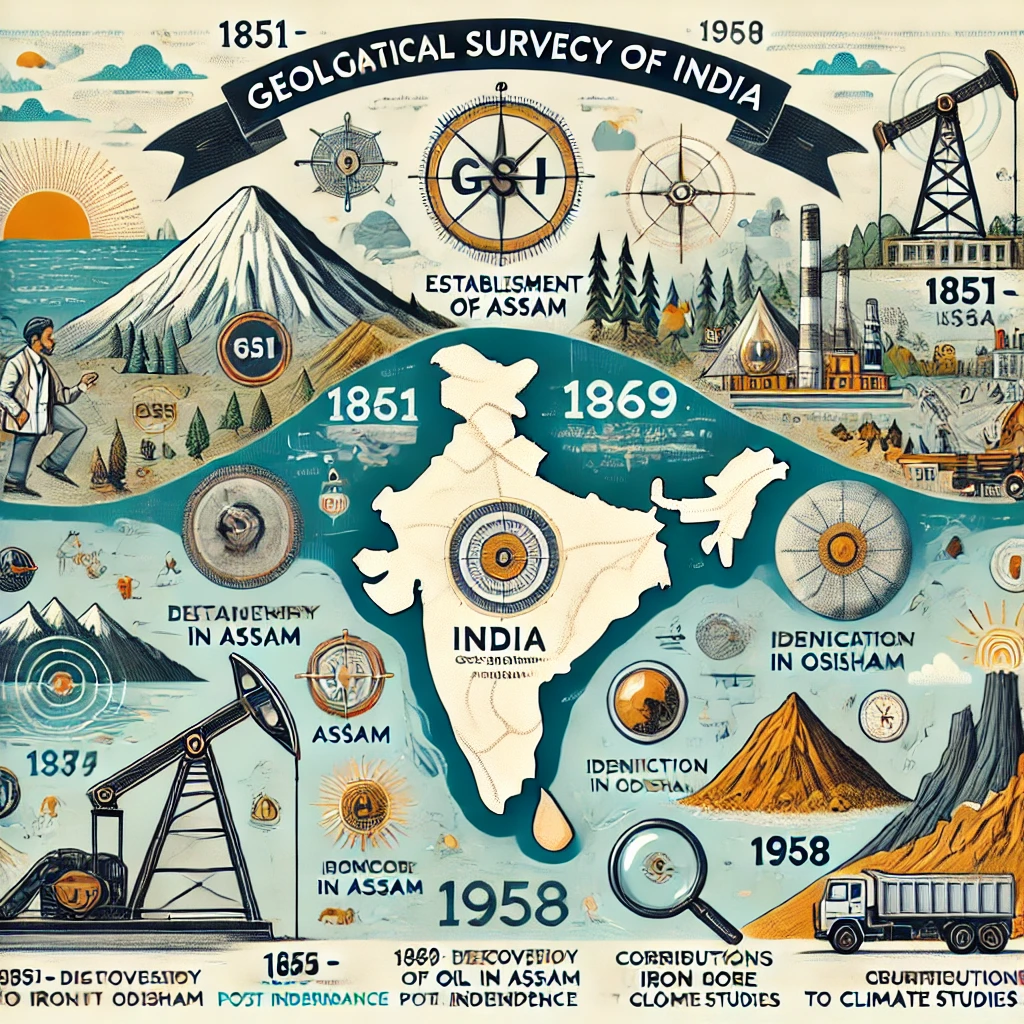The Geological Survey of India (GSI) stands as one of the oldest and most prestigious scientific institutions in the world. Established on March 5, 1851, its initial mission was to locate coal reserves to support the expanding railway network. Over the years, GSI has evolved into a premier organization dedicated to geological research, mineral exploration, and mapping India’s diverse geological landscapes.
Milestones in the Journey of GSI
1️⃣ Establishment and Early Contributions (1851)
The foundation of GSI marked the beginning of systematic geological studies in India. Under the leadership of Sir David Hiram Williams, the institution initially focused on identifying coal deposits essential for industrial and railway development.
2️⃣ Discovery of Oil in Assam (1869)
GSI played a pioneering role in the discovery of India’s first oil reserves in Assam. This crucial finding laid the foundation for India’s petroleum industry, leading to further exploration of hydrocarbon resources.
3️⃣ Identification of Iron Ore in Odisha (1928)
In 1928, GSI identified rich iron ore deposits in Odisha, a discovery that significantly contributed to India’s steel industry. This milestone helped in the establishment of major steel plants and boosted industrial growth.
4️⃣ Post-Independence Expansion (1958-Present)
Following India’s independence, GSI became an independent entity, expanding its research and exploration beyond minerals. The organization played a vital role in seismology, environmental studies, and climate research, strengthening India’s scientific foundation.
5️⃣ Present-Day Contributions
Today, GSI is at the forefront of earthquake monitoring, mineral mapping, and climate change studies. It continues to support infrastructure projects, natural disaster assessments, and sustainable resource management.
Constitutional and Legal Aspects of GSI
The Geological Survey of India (GSI) is not a constitutional body but functions as an attached office under the Ministry of Mines, Government of India. It is also not a statutory body because it was not established by an act of Parliament. Instead, it operates as an executive body that derives its mandate from government policies and administrative orders rather than a specific legal statute.
Why is GSI Not a Statutory Body?
A statutory body is an organization that is created by an act of Parliament and derives its authority directly from the law. Examples include the Election Commission of India (Article 324) and the National Human Rights Commission (Protection of Human Rights Act, 1993).
GSI, however, was established in 1851 during British rule as a scientific research institution. Over time, it has continued to function based on government orders and administrative decisions rather than through a specific legislation. This means that while it plays a significant role in geological research and mineral exploration, it does not have independent statutory authority and remains under direct government control.
Relevant Constitutional Provisions & Articles:
- Article 246 & Seventh Schedule – Mineral and mines regulation falls under the Union List (Entry 54) and the State List (Entry 23), giving the central government the authority to legislate on mineral exploration.
- Article 297 – States that minerals and valuable resources found within India’s territorial waters, continental shelf, and exclusive economic zones belong to the Union Government.
- Article 39(b) – Mandates that ownership and control of material resources should be distributed to subserve the common good, which is a guiding principle in mineral exploration policies.
- Article 48A – Provides for the protection and improvement of the environment, which aligns with GSI’s role in environmental and geological conservation.
- Mines and Minerals (Development and Regulation) Act, 1957 – Governs mineral exploration and extraction in India, with GSI playing a critical role in its implementation.
- Environment Protection Act, 1986 – Under which GSI conducts environmental impact assessments related to mining and geological activities.
Shaping India’s Geological Future
From the towering Himalayas to the vast Deccan Traps, GSI has been instrumental in enhancing India’s understanding of its geological heritage. The organization remains committed to advancing geoscience research, ensuring resource sustainability, and contributing to national development.
🔎 Have you ever visited a site mapped by GSI? Share your experience in the comments!



